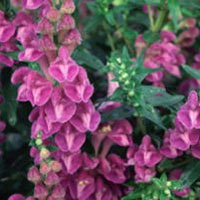American Scullcap
Uses
Parts Used & Where Grown
Scullcap is a member of the mint family. Scutellaria lateriflora grows in eastern North America and is most commonly used in United States and European herbal products containing scullcap. The above-ground (aerial) part of the plant is used in herbal preparations. It is not interchangeable with Chinese scullcap.
Our proprietary “Star-Rating” system was developed to help you easily understand the amount of scientific support behind each supplement in relation to a specific health condition. While there is no way to predict whether a vitamin, mineral, or herb will successfully treat or prevent associated health conditions, our unique ratings tell you how well these supplements are understood by the medical community, and whether studies have found them to be effective for other people.
For over a decade, our team has combed through thousands of research articles published in reputable journals. To help you make educated decisions, and to better understand controversial or confusing supplements, our medical experts have digested the science into these three easy-to-follow ratings. We hope this provides you with a helpful resource to make informed decisions towards your health and well-being.
3 Stars Reliable and relatively consistent scientific data showing a substantial health benefit.
2 Stars Contradictory, insufficient, or preliminary studies suggesting a health benefit or minimal health benefit.
1 Star For an herb, supported by traditional use but minimal or no scientific evidence. For a supplement, little scientific support.
This supplement has been used in connection with the following health conditions:
| Used for | Why |
|---|---|
|
1 Star
Anxiety
Refer to label instructions
|
American scullcap is one of a group of “nerve tonic” (nervine) herbs used in traditional herbal medicine for people with anxiety, with few reports of toxicity.
Other nervines include oats (oat straw), hops, passion flower, , wood betony, motherwort, pennyroyal, and linden. |
|
1 Star
Insomnia
Refer to label instructions
|
American scullcap is commonly recommended by doctors as a mild sedative for those suffering from insomnia or nervous exhaustion.
Combining valerian root with other mildly sedating herbs is common both in Europe and the United States. Chamomile, hops, passion flower, lemon balm, , and catnip are commonly recommended by doctors. These herbs can also be used alone as mild sedatives for those suffering from insomnia or nervous exhaustion. Chamomile is a particularly good choice for younger children whose insomnia may be related to gastrointestinal upset. Hops and lemon balm are approved by the German government for relieving sleep disturbances. |
|
1 Star
Pain
Refer to label instructions
|
American skullcap has been historically used to relieve pain.
Other herbs that have been historically used to relieve pain (although there are no modern scientific studies yet available) include valerian, passion flower, , Piscidia erythrina, and crampbark (Viburnum opulus). |
Traditional Use (May Not Be Supported by Scientific Studies)
How It Works
How It Works
Few studies have been completed on the constituents of American scullcap. One of its constituents, scutellarian, has been reportedly shown to have mild sedative and antispasmodic actions in animal studies.2 Human trials have not yet been conducted to confirm the use of scullcap for anxiety or insomnia.
How to Use It
Scullcap tea can be made by pouring 1 cup (250 ml) of boiling water over 1–2 teaspoons (5–10 grams) of the dried herb and steeping for 10 to 15 minutes. This tea may be drunk three times per day.3 Alternatively, tincture made from fresh scullcap, 1/3–3/4 teaspoon (2–4 ml) three times per day, may be taken.
Interactions
Interactions with Supplements, Foods, & Other Compounds
Interactions with Medicines
Side Effects
Side Effects
Use of scullcap in recommended amounts is generally safe. However, scullcap use during pregnancy and breast-feeding should be avoided due to limited information about its safety. Cases of liver damage have been reported in association with the intake of scullcap. However, on closer examination, it appears these scullcap products actually contained germander (Teucrium chamaedrys), an herb known to cause liver damage.4
One case report exists of a 28-year-old man who died of liver failure after taking unspecified amounts of scullcap, pau d’arco and zinc.5 It appears likely that this, too, may have been a case of adulteration of scullcap with germander.6
References
1. Hoffman D. The Herbal Handbook: A User's Guide to Medical Herbalism. Rochester, VT: Healing Arts Press, 1988, 77.
2. Foster S. Herbs for Your Health. Loveland, CO: Interweave Press, 1996, 86-7.
3. Hoffmann D. The New Holistic Herbal. New York: Barnes & Noble Books, 1990, 233.
4. McGuffin M, Hobbs C, Upton R, Goldberg A. American Herbal Products Association's Botanical Safety Handbook. Boca Raton, FL: CRC Press, 1997, 105.
5. Hullar TE, Sapers BL, Ridker PM, et al. Herbal toxicity and fatal hepatic failure [letter]. Am J Med 1999;106:267-8.
6. Brown D. A case of fatal liver failure associated with herbal products. Healthnotes Rev Complement Integrative Med 1999;6:176-7.
Last Review: 05-12-2015

Copyright © 2025 TraceGains, Inc. All rights reserved.
Learn more about TraceGains, the company.
The information presented by TraceGains is for informational purposes only. It is based on scientific studies (human, animal, or in vitro), clinical experience, or traditional usage as cited in each article. The results reported may not necessarily occur in all individuals. For many of the conditions discussed, treatment with prescription or over the counter medication is also available. Consult your doctor, practitioner, and/or pharmacist for any health problem and before using any supplements or before making any changes in prescribed medications. Information expires December 2025.



